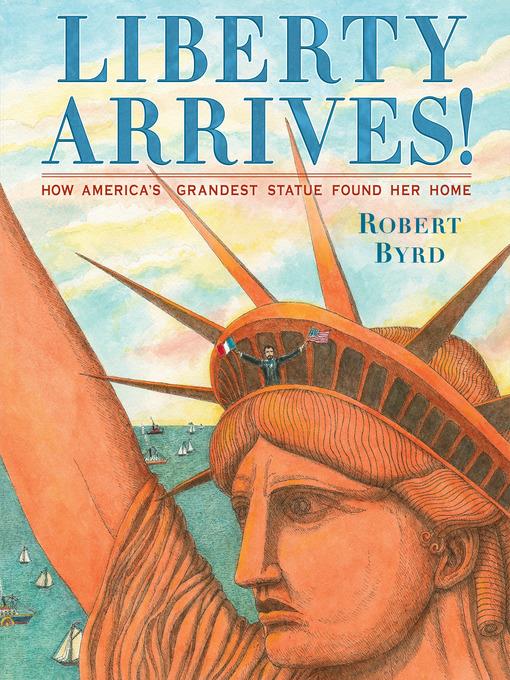
Liberty Arrives!
How America's Grandest Statue Found Her Home
فرمت کتاب
ebook
تاریخ انتشار
2019
Lexile Score
900
Reading Level
4-5
ATOS
6.1
Interest Level
K-3(LG)
نویسنده
Robert Byrdشابک
9780525554516
کتاب های مرتبط
- اطلاعات
- نقد و بررسی
- دیدگاه کاربران
نقد و بررسی

April 22, 2019
Byrd tells an informative and visually detailed story about the inception, construction, and transportation of the Statue of Liberty. The text introduces French sculptor Frédéric-Auguste Bartholdi, whom a French judge commissioned to create a U.S. monument—as long as the young nation could raise money for the statue’s base. Byrd’s finely lined ink and watercolor illustrations show the incremental and labor-intensive process of building the statue. Laborers are seen hammering copper sheets into wooden molds and riveting “the sheets together like a quilt.” Byrd movingly describes how, when funding for the pedestal came up short, adults and children across America made donations. This moving ode to a monument—and the collaboration that led to her creation—concludes with a portrait-oriented spread showing Lady Liberty gleaming against sunset skies. Back matter features photographs, a timeline, and a discussion of the statue’s symbolism. Ages 6–9.

Starred review from May 1, 2019
Lady Liberty's arrival almost didn't happen. Intended as a 100th-birthday gift from France, the statue was the brainchild of a French judge who envisioned a symbol of friendship between the two nations and hired sculptor Frederic-Auguste Bartholdi to create it. After choosing its New York Harbor site, he fashioned numerous, ever larger models and chose copper for its light weight. Alexandre-Gustave Eiffel devised an "iron skeleton" to support Liberty, and then the completed statue was exhibited in Paris; parts of it had already been shown in the States. A pedestal was designed--with no funds to build it. Nonetheless, Bartholdi had the statue's pieces shipped in crates to America nine years after the centennial. Finally, Joseph Pulitzer successfully encouraged Americans to donate; Emma Lazarus' poem "The New Colossus" was initially written as a fundraiser. In a crowded field, Byrd's signature narrative and artistic styles elevate this effort. Pages with type set in newspaperlike double columns feature outsized, capitalized headlines and datelines denoting years and places. Spreads include masterly ink-and-watercolor illustrations with details that invite readers to pore over artwork. The author's awestruck writing, featuring punchy, taut sentences, makes for fast-paced reading, as do dramatic page turns, and it emphasizes the grandeur of the enterprise; fascinating, quirky facts abound. In most illustrations, persons default white. A book worthy of the statue herself. (measurements, timeline, facts about the statue and historical figures, author's note, bibliography) (Informational picture book. 7-11)
COPYRIGHT(2019) Kirkus Reviews, ALL RIGHTS RESERVED.

July 1, 2019
Gr 1-4-As a national emblem of America's immigrant history, the Statue of Liberty holds a special place in the country's cultural identity. From idea to implementation, Byrd tells the miraculous story of Lady Liberty and how her existence almost didn't happen. Meant to be a gift to the United States for its centennial celebration, she was the brainchild of a French judge and a young sculptor, but it took a full 21 years to make the grand plan a reality. Lengthy text and ink and watercolor illustrations work together to thoroughly describe everything from the early stages of planning to the complicated construction of the actual statue. Byrd's narrative makes clear just how many people, including everyday Americans, were involved in supporting the project's installment. Colorful artwork, many with inset details, make for a visually interesting read with plenty to pore over and discuss. Back matter includes a time line, a diagram of the statue with measurement details, and a helpful bibliography. Short bios include some of the more prominent Americans who were vital to the final construction of the statue. VERDICT While there are a number of titles on this topic, this one offers a unique and valuable perspective and will have a place on most library shelves. Report writers will find this engaging and accessible.-Jody Kopple, Shady Hill School, Cambridge, MA
Copyright 2019 School Library Journal, LLC Used with permission.

June 1, 2019
Grades 2-5 Big ideas are not small things to accomplish, notes the sage introduction to this account of the Statue of Liberty's early years. Starting in 1840s France, Sibert Honor Book creator Byrd tells how the idea for a big statue celebrating the U.S.' one hundredth birthday was conceived, planned, funded, and executed. Highlights include the sculptor Bartholdi's inspirational tour of America and his attempts to raise funds for the pedestal. Each oversize page is arranged into two columns of engaging writing; large, captioned ink-and-watercolor illustrations; and spot art to extend the text, with each double-page presenting a different chapter of the saga. Byrd's excellent art shows the work of sculptors and engineers through diagrams and cross-sections, recreations of photographs and political cartoons, and scenes of Parisians cheering on the work and of Americans celebrating the 1886 dedication. The third-person narrator is entertaining and energetic, and strong back matter includes measurements, a time line, an exploration of the symbolism, features on certain dramatis personae, bibliographies, and an explanation of Lady Liberty's color transformation from her original copper to green.(Reprinted with permission of Booklist, copyright 2019, American Library Association.)

























دیدگاه کاربران